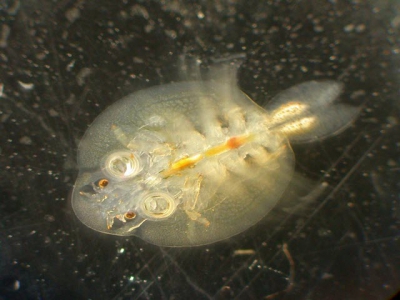Fish disease - Fish lice

Fish liceFish lice, otherwise known as Argulus, are disc-shaped crustaceans that feed on fish by injecting a digestive enzyme into the skin or gills of a fish and then sucking out the putrefied flesh. They are visible to the naked eye, usually measuring 1/5 of an inch to 2/5 of an inch (5mm to 10mm), and are a common parasite in fish ponds. Fish lice feeding on fish can also open the door for secondary infections.
Biologically, fish lice are classed as Branchiura, or fish parasites. They are also biologically classifiable as Crustacea with a rigid chitin exoskeleton, which must be shed as the creature grows larger.
Fish lice mate when on the host fish, and afterward the female goes to lay eggs on plants or other objects toward the bottom of the water. The eggs are generally laid in the winter and hatch around the spring, when water temperatures rise. The creatures go through several metamorphic changes in their development, and usually secure a fish-host within four days. They continue to grow while on the fish and the growth cycle can take anywhere between 30 and 100 days, depending on variables such as temperature.
There are two large suckers on the body of fish lice used for feeding in conjunction with their slightly smaller mouth. This causes the fish host both irritation and stress and the affected area usually becomes inflamed. The areas of tissue damaged by the fish lice also give bacteria a chance to infect the fish, possibly leading to conditions such as skin ulcers and gill disease. The stress caused by fish lice can lead to secondary parasitic infections such as Costia and white-spot. It is also a possibility that infections are injected into the fish as the lice feed.

Using a chitin inhibitor is an alternative solution, which prevents the young fish lice from developing when they melt their exoskeleton; this treatment is not toxic to fish. Chitin inhibitors can remove all traces of crustacean parasites in as little as five days.
Related news
 Minty feed may boost tilapia survival during disease challenge
Minty feed may boost tilapia survival during disease challenge Supplementing farmed Nile tilapia feeds with peppermint essential oil may boost fish performance and survival following a disease challenge, say researchers.
 Boost for Colombian tilapia productivity
Boost for Colombian tilapia productivity Pharmaq has formed a strategic partnership with Colombia’s largest tilapia producer, Piscicola Botero, in a bid to improve productivity and sustainability
 Fish disease - Eye lesions
Fish disease - Eye lesions Eye problems in fish can have a long row of different causes from bacteria to poor nutrition. The